Patrick K. Sullivan, MD, FACS
& David P. Singer, MD
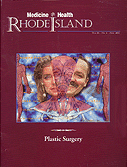
As seen in Medicine and Health / Rhode Island
magazine, Vol. 84, No. 12, December 2001.
Shape and form often define art. Similarly, elements of facial and cranial shape are closely associated and bring form to the human face – our interface with the world. Key facial features are of primary importance in the development of the face, the person, and the personality. Structural elements such the nose, chin, and ears made up of bone and or cartilage are not only dominant features but also can be artistically shaped and sculpted to bring the face into a more normal, aesthetically pleasing balance.
Since the popularization of the term “plastique” via the Handbuch der plastischen Chirurgie in 1838, the discipline of plastic surgery continues to evolve.1 The reconstructive aspects of the field in the pediatric population are widely recognized, particularly in facial dysmorphologies including the treatment of craniosynostosis. In contrast, the facial aesthetics of the pediatric patient with more subtle dysmorphology has often been less emphasized. The importance of facial aesthetics in the development of the personality, social skills, and self-esteem has been less estimated. Overall, conservative facial reshaping with a respect for the pediatric patient can have significant impact on children and adolescents.
Psychological influences define the perception of body image and underscore the way external appearance affects behavior. Plastic surgery to correct an unattractive feature can be enormously successful and remarkably free of conflict in this population. Children and adolescents undergo rapid reorganization of the self-image after plastic surgery with subsequent positive changes in behavior and interpersonal interactions.2 Parents have reported to us dramatic and rapid improvements in the behavior of children who have undergone ear reshaping, for example. The ridicule of peers can be powerful. Adolescents with nasal deformities may curtail their socialization rather then deal with painful interactions and rejection. Patient selection and timing of surgery, however, are both important factors in achieving successful outcomes in these young patients. The core values to guide in patient selection for these procedures are physical development, age, psychological stability and maturity, and clear realistic expectations of both the patient and the family. Amongst the pediatric population, the areas of most common concern are the ear, nose, and chin.
Ear
The protruding ear, defined by prominence of the auricle beyond 1.8-2.0 centimeters from the helical rim to the scalp, can be a common finding.3 The acceptable variability of ear prominence is dictated by individual preferences. The condition results from embryonic arrest during the final convolutions of the ear with failure of folding of the antihelix as well as overdevelopment of the conchal wall. [Figure 1] The deformity is usually found bilaterally.4,6 Further, familial inheritance patterns have been observed, including an autosomal dominant expression pattern seen in the Caucasian population.
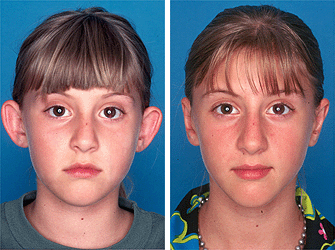 |
| Figure 1a. The face pre-op. Â Â Â Â Figure 1b. The face post-op. |
| Figure 1a. This child had difficulty with protruding ears.
Figure 1b. Child appears after otoplasty surgery with the incision hidden behind the ear. |
The anatomic manifestations and distortions of prominent ears can be disturbing and distinguishing features for a child and his or her family. The appropriate time to address these concerns is governed by psychologic and physical development. The body image usually begins to form around the age of 4 to 5 years. At this age the child begins to be aware of being different and is motivated to conform. When this awareness begins, it will make him or her more cooperative with the surgery and the restrictions it entails.4 Also, when the child starts school, s/he has increasing social interactions – again provoking self-awareness. On the other hand, a large percentage of the ear growth is not complete until approximately the age of 6. 5 The ear continues to enlarge mostly in its vertical dimension throughout life, predominantly due to elongation of the earlobe.3 Hence, correction of the deformity via otoplasty is offered to patients at approximately age 6. Lastly, there is some credence to early tape repositioning of prominent ears in infants to elude the need for surgical correction.
Otoplasty is usually performed under general anesthesia in children and with intravenous sedation in adults. The procedure involves an incision carefully hidden behind the ear; it can rarely be seen. Cartilage molding is done via otobrading, and suture reshaping/fixation to decrease ear projection. The ear is meticulously sculpted in an effort to have it look completely natural. A protective dressing is used continuously for one week followed by the use of a protective band at night for several more weeks. This technique has a low incidence of complications. Recurrences are rare, while patient and family satisfaction tends to be high.
Nose
The pediatric dictum that “children are not little adults” applies to nasal surgery. There are restraints imposed by immaturity of tissue as well as normal nasal growth. The size and shape of the nose changes dramatically from infancy to adulthood. Although there is no definitive consensus, many feel the nose should remain undisturbed until the postpubertal growth spurt.8 By this time, the adolescent patient has a more developed personality. This development is necessary to address the complex concerns and issues necessary for rhinoplasty. Hence, rhinoplasty can generally be offered to an adolescent at approximately 16 years of age.
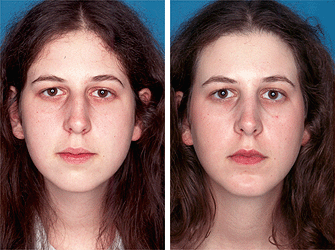 |
|
| Figure 2a. This 17-year-old was concerned about the appearance of her nose. She did not like the nasal shape, especially the nasal hump. | Figure 2b. The post-operative view five years after treatment. |
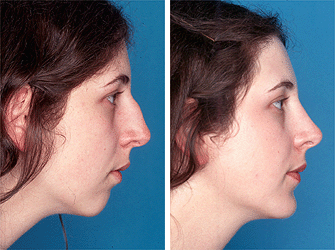 |
|
| Figure 3a. Upon reviewing the photographs with the patient and her parents we also discussed the artistic facial balance and the chin position. We then went over treatment options to balance the face. | Figure 3b. The lateral view demonstrates how the dorsal nasal deformity has been removed and the nose has been reshaped all via internal nasal incisions. The chin advancement was done by an intraoral incision and an osteotomy, sliding the chin forward, where it was then fixed in a new position to give a better artistic balance to the face. |
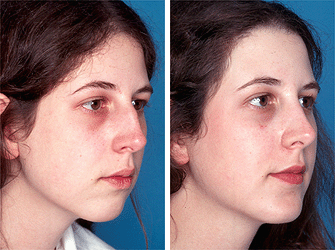 |
|
| Figure 4a. The oblique view also demonstrates the retruded chin. | Figure 4b. The oblique view demonstrates the new facial balance. |
Rhinoplasty is performed to address the concerns of the patient and to achieve a natural appearing nose that artistically matches other features of the face. The nasal recontouring should enhance the artistic match of the nose to the face without obliterating ethnic and individual features. Thus, the operative plan is defined by these goals. The nasal skin thickness is an important variable because a thick skin sleeve limits what can be accomplished surgically.13 The bony framework of the nose frequently needs to be altered in order to achieve the most pleasant shape and function. Techniques have been developed to perform this in a safe, reliable and reproducible way.14,15 Overall, there should be a harmonious balance with surrounding structures including the cheeks, forehead and chin.
A nasal splint is worn for one week. Nasal packing is rarely necessary for rhinoplasty alone. Nasal airway obstruction can be addressed simultaneously during rhinoplasty when indicated. And we have found that both the septum and turbinates may require treatment in order to achieve normal function.
Chin
Aesthetic beauty of the lower face is dependent on the shape and position of the chin.9 The posture and function of the lips also is influenced by chin position.1 Overall, facial balance is determined predominately by the relationship of the nose and chin. [Figure 2a]. Genioplasty can be done to address a variety of mandibular positions. Key aspects to chin dysmorphology are anterior-posterior projection, inadequate or excessive vertical height, and depth of the labiomental crease.10 Not only are these aesthetic concerns, but also functional considerations relating to malocclusion and mastication can be associated.11
Timing mandibular surgery is variable. Genioplasty is usually considered after eruption of adult dentition as well as completion of craniofacial growth in adolescence. Preoperative photographs and cephalometric roentgenograms are part of surgical planning.1 Numerous surgical approaches are available to the surgeon based on the patient’s individual characteristics. These include alloplastic augmentation, sliding genioplasty, interposition alloplastic/autoplastic materials after horizontal osteotomy, and vertical shortening horizontal osteotomy. The field has continued to advance with the advent of plating systems to stabilize the bone in its new position after the osteotomy. [Figure 3B] Despite these excellent techniques, there is no substitute to accurate diagnosis of problems and careful planning.12 Overall, genioplasty serves as a unique opportunity to improve facial aesthetics in select patients.10
Computer imaging can be used to alter photographs preoperatively and show the patient an image of how they might look postoperatively. The capabilities of computers and surgeons, though, do not mesh. Although the computer operator can easily make facial changes show up clearly on the screen, the surgeon may not be able to make those changes. Because computer-imaging may encourage false expectations, I avoid it.
Summary
Facial aesthetics can be enhanced by otoplasty, rhinoplasty and genioplasty. Excellent outcomes can be obtained given appropriate timing, patient selection, pre-operative planning, and artistic sculpting of the region with the appropriate surgical technique. Choosing a patient with mature psychological, developmental, and anatomic features that are amenable to treatment in the pediatric population can be challenging, yet rewarding.
References
- McCarthy JG. Plastic Surgery. W.B. Saunders Company, 1990.
- McGrath MH. Plastic surgery and the teenage patient. J Pediatric Adolescent Gynecol 2000;13:105.
- Spira M. Otoplasty: What I do now: A 30-year perspective. Plast Reconstr Surg 1999;104:834.
- Hackney FL, Snively SL. Plastic surgery of the ear. Selected Readings in Plast Surg 1997;8:1.
- Adamson JE, Horton CE, Crawford HH. The growth pattern of the external ear. Plast Reconstr Surg 1965; 36:466.
- Erol O. New modification in otoplasty: Anterior approach. Plast Reconstr Surg 2001;107:193.
- McDowell A.J. Goals in otoplasty for protruding ears. Plast Reconstr Surg 1968; 41:12.
- Burget GC, Menick FJ. Aesthetic Reconstruction of the Nose. Mosby, 1994.
- Daniel RK. Aesthetic Plastic Surgery Rhinoplasty. Little, Brown and Company, 1993.
- Spear SL, Kassan M. Genioplasty. Clin Plast Surg year 16: 695.
- Hull MJ, Smith RL. The retrognathic mandible-surgical correction. Oral Surg Oral Med Oral Pathol year 41: 2.
- Zide BM, Pfeifer TM, Longaker MT. Chin surgery: I. Augmentation-The allures and the alerts. Plast Reconstr Surg 1999;104:1843.
- Garramone R, Sullivan P, Devaney K. Bulbous nasal tip: An anatomical and histological evaluation. Annals Plast Surg 1995;34:288-91.
- Harshbarger R, Sullivan P. Lateral nasal osteotomies: Implications of bony thickness on fracture patterns. Annals Plast Surg 1999;42:365-71.
- Harshbarger R, Sullivan P. The optimal medial osteotomy: A study of nasal bone thickness and fracture patterns. Plast Reconstr Surg in press.
Patrick K. Sullivan, MD, is Associate Professor, Plastic Surgery, Brown Medical School.
David P. Singer, MD, is a resident in the Department of Plastic Surgery, Brown Medical School.
Patrick K Sullivan MD, is Associate Professor of Plastic Surgery, Brown Medical School.
